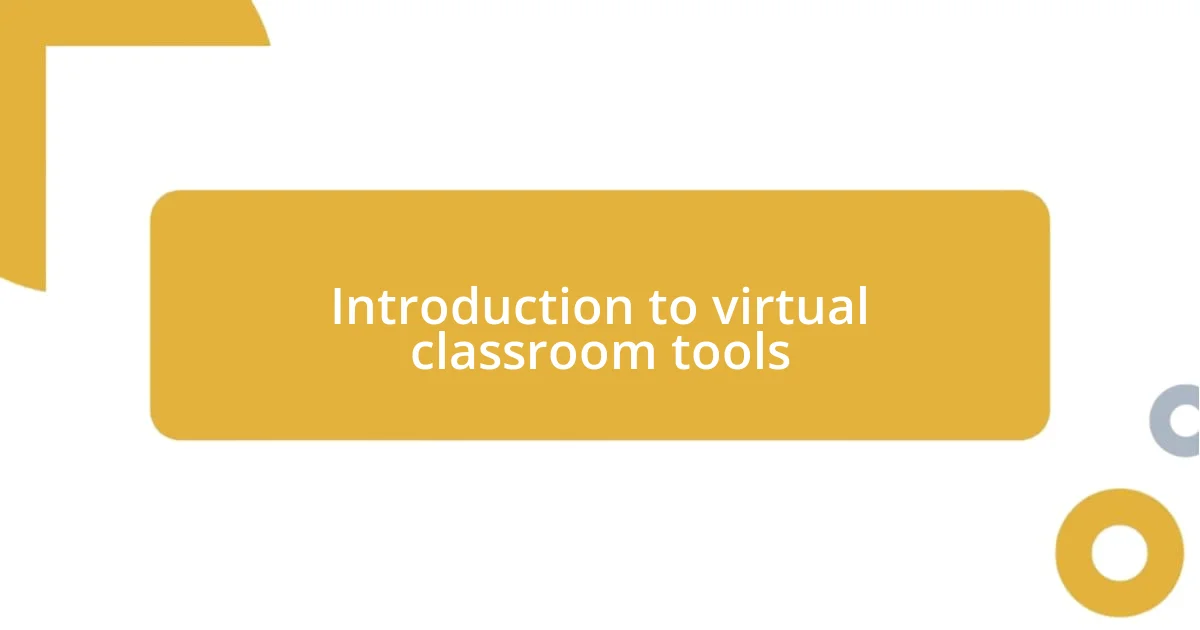Key takeaways:
- Virtual classroom tools enhance engagement through interactive features like polls, quizzes, and collaborative spaces, allowing diverse student interactions.
- Effective virtual teaching strategies include user-friendly platforms, robust communication options, and a mix of synchronous and asynchronous activities to foster engagement and confidence.
- Future trends in education may involve AI for personalized learning, immersive technologies for enriched experiences, and a greater focus on social-emotional learning to build community connections.

Introduction to virtual classroom tools
Virtual classroom tools are game-changers for both educators and students. I remember the first time I logged into a video conferencing platform; I felt a mix of excitement and nervousness. Would the technology work smoothly? Would my students engage in a virtual environment? These tools have transformed my teaching approach, enabling dynamic interactions that were once only possible face-to-face.
One of the striking aspects of virtual classroom tools is their ability to bridge geographical gaps. I once conducted a lesson with students from different parts of the country, and the energy was electrifying. Watching diverse perspectives come together in real-time was a vivid reminder of the power of technology in education. Isn’t it fascinating how a simple click can connect us with minds from far and wide?
The functionality of these tools often surprises me; they can enhance learning beyond traditional methods. Features like breakout rooms and collaborative whiteboards have allowed me to create a more engaging and hands-on experience. How often have you found a tool that makes learning feel more like a conversation than a lecture? That’s precisely what I love about virtual classrooms—they foster a community, even when we’re all physically apart.

Key features of effective tools
When choosing effective virtual classroom tools, I find that user-friendliness is crucial. I vividly remember a session where half the students struggled to navigate a complicated interface. It was a reminder that simplicity matters; if students can’t easily engage with the platform, they miss out on learning opportunities. A clean, intuitive design can make all the difference.
Collaboration features often lead to rewarding experiences in virtual classrooms. For instance, I’ve had students work together on a shared document during live sessions, and it was incredible to watch their ideas build off each other. Having tools that foster this kind of teamwork not only enhances learning but also boosts students’ confidence in their abilities to contribute in real-time.
Lastly, I can’t stress enough the importance of robust communication options. Being able to interact through chat and video simultaneously has enriched my lessons immensely. I recall a moment when a student, who usually kept quiet in physical classrooms, expressed their thoughts passionately in the chat. This level of engagement is what effective tools should promote; having various ways for students to connect enhances the overall classroom experience.
| Key Feature | Description |
|---|---|
| User-Friendliness | The interface should be intuitive to ensure all students can navigate easily. |
| Collaboration Options | Tools that allow real-time collaboration enrich the learning experience. |
| Communication Tools | Multiple communication methods, like chat and video, foster engagement. |

Essential tools for engagement
Engagement in a virtual classroom heavily relies on the right tools. I have found that integrating interactive polls or quizzes during a lesson can turn a passive experience into an active one. For example, after launching a quick poll on students’ thoughts about a novel we were reading, I witnessed a lively discussion unfold. It was both exciting and enlightening to see students share their differing viewpoints; that kind of interaction keeps energy levels high and makes learning enjoyable.
Here are some essential tools that have proven effective for engagement:
- Interactive Polls: Instant feedback on student opinions helps spark discussions.
- Live Quizzes: Gamified assessments encourage participation and create a sense of friendly competition.
- Discussion Boards: Allowing students to post questions and reply encourages ongoing engagement beyond class time.
- Whiteboard Tools: They enable collaborative brainstorming where students can express their creativity together in real-time.
In my experience, leveraging these tools not only captivates attention but also cultivates a richer learning environment, and I believe they play a pivotal role in maintaining student connection and enthusiasm in virtual settings.

Best practices for facilitating interaction
Facilitating interaction in a virtual classroom requires intentional strategies that resonate with students. I remember a time when I incorporated breakout rooms for small group discussions; it was fascinating to see shy students shine in a more intimate setting. This allowed them to express themselves without the pressure of speaking in front of everyone, proving that creating safe spaces nurtures student confidence and participation.
Using a mix of synchronous and asynchronous activities can greatly enhance interaction. One time, I set up a discussion thread for students to share their thoughts on a lesson, complemented by a live Q&A session the following week. I was pleasantly surprised by how this combination allowed students to digest the material at their own pace while also feeling excited about sharing insights in real-time. This dual approach fosters an ongoing dialogue that engages students more effectively.
Finally, I find that nurturing a community spirit is key to keeping students engaged. I often encourage icebreakers at the start of a session, which not only lightens the mood but also helps students connect with one another. Reflecting on that experience, it’s clear that when students feel a sense of belonging, they are far more likely to participate actively. Isn’t it amazing how simple activities can lead to profound connections?

Strategies for assessing student performance
Assessing student performance in a virtual classroom can be a nuanced task, but I’ve learned some effective strategies along the way. For instance, I’ve found that incorporating regular formative assessments—like short quizzes or reflections—offers a clearer picture of student understanding. I remember one semester, I used a “minute paper” at the end of each class, where students had to jot down their biggest takeaway. The insights I gained from these little snippets were invaluable, shedding light on which concepts needed revisiting.
Another approach I believe is particularly effective involves peer assessments. Encouraging students to review each other’s work not only fosters collaboration but also sharpens their critical thinking skills. I once facilitated a session where students provided constructive feedback on draft projects, creating a supportive environment that amplified their confidence. It turned out to be a fantastic way for them to engage with the material and with each other’s perspectives, ultimately deepening their understanding of the subject matter. Have you ever noticed how students often appreciate seeing things through their peers’ eyes?
Finally, I can’t stress enough the importance of personalized feedback. I strive to keep my feedback descriptive and supportive. Reflecting on my own experience, there was a time when I offered a student detailed feedback on her project. She later shared how those comments motivated her to improve and led to greater academic resilience. This interaction illuminated for me how powerful targeted feedback can be in boosting student engagement and performance. It’s a reminder that every little interaction can have a ripple effect on a student’s learning journey.

Troubleshooting common technical issues
When it comes to troubleshooting technical issues in a virtual classroom, one of the most common problems I’ve faced is connectivity issues. I recall a day when half my class was struggling to join the session due to unstable internet connections. This taught me the importance of being proactive; I now suggest students test their connections before class starts. It’s surprising how a little preparation can save a lot of frustration for everyone involved.
Another frequent concern is audio feedback during sessions. I remember sitting through what felt like an eternity of echoing voices, which not only distracted me but also made it hard for students to focus. To tackle this, I now remind students to mute their microphones when they’re not speaking. It’s a small step, but it can make a huge difference. Have you ever noticed how simple habits can transform the classroom experience?
Finally, I learned the hard way about the importance of having a backup plan. Once, I encountered a platform outage just before a crucial lecture, leaving me scrambling. From that experience, I’ve started recording sessions and preparing alternative resources. This way, if anything goes awry, my students still have access to the necessary materials. It’s moments like these that really highlight the importance of adaptability in our technology-driven world. How do you prepare for the unexpected?

Future trends in virtual classrooms
Looking ahead, I predict we’ll see an increase in the use of artificial intelligence (AI) in virtual classrooms. I remember a particular instance when a chat bot helped manage student inquiries during a busy office hours session. It was such a relief to focus on deeper discussions while the bot simultaneously answered common questions. Can you imagine how AI could further personalize learning experiences, tailoring content to each student’s unique pace?
Another trend I anticipate is the integration of immersive technologies like virtual and augmented reality. I once participated in an experimental class that included a virtual tour of ancient ruins. The level of engagement was off the charts! It made me realize how these technologies can turn abstract concepts into tangible experiences. Isn’t it exciting to think about how future classrooms could bring history or science to life in ways we’ve only dreamt of?
Lastly, the growing emphasis on social-emotional learning (SEL) stands out to me. In my teaching practice, I’ve noticed how important it is to check in on students’ well-being, especially in a virtual setup where isolation can occur. I recall a group activity designed around sharing personal anecdotes that fostered connections, making the virtual space feel warmer and more inviting. How essential will it be, moving forward, to create a sense of community as technology continues to evolve?













